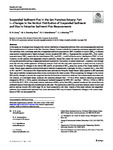Suspended Sediment Flux in the San Francisco Estuary: Part I—Changes in the Vertical Distribution of Suspended Sediment and Bias in Estuarine Sediment Flux Measurements
| dc.contributor.author | Livsey, DN | |
| dc.contributor.author | Downing-Kunz, MA | |
| dc.contributor.author | Schoellhamer, DH | |
| dc.contributor.author | Manning, Andrew | |
| dc.date.accessioned | 2020-07-09T20:54:47Z | |
| dc.date.available | 2020-07-09T20:54:47Z | |
| dc.date.issued | 2020-04-22 | |
| dc.identifier.issn | 1559-2723 | |
| dc.identifier.issn | 1559-2731 | |
| dc.identifier.uri | http://hdl.handle.net/10026.1/15970 | |
| dc.description.abstract |
In this study, we investigate how changes in the vertical distribution of suspended sediment affect continuous suspended sediment flux measurements at a location in the San Francisco Estuary. Current methods for measuring continuous suspended sediment flux estimates relate continuous estimates of suspended-sediment concentration (SSC) measured at-a-point (SSCpt) to discrete cross-section measurements of depth-averaged, velocity-weighted SSC (SSCxs). Regressions that compute SSCxs from continuous estimates of SSCpt require that the slope between SSCpt and SSCxs, controlled by the vertical distribution of SSC, is fixed. However, in tidal systems with suspended cohesive sediment, factors that control the vertical SSC profile—vertical turbulent mixing and downward settling of suspended sediment mediated by flocculation of cohesive sediment—constantly vary through each tide and may exhibit systematic differences between flood and ebb tides (tidal asymmetries in water velocity or particle size). We account for changes in the vertical SSC profile on estimates of SSCxs using time series of the Rouse number of the Rouse-Vanoni-Ippen equation combined with optical turbidity measurements, a surrogate for SSCpt, to predict SSCxs from 2009 to 2011 and 2013. Time series of the Rouse number were estimated by fitting the Rouse-Vanoni-Ippen equation to SSC estimated from optical-turbidity measurements taken at two elevations in the water column. When accounting for changes in the vertical SSC profile, changes in not only the magnitude but also the direction of cumulative sediment-flux measurements were observed. For example, at a mid-depth sensor, sediment flux estimates changed from − 319 kt (± 65 kt, negative indicating net seaward transport) to 482 kt (± 140 kt, positive indicating net landward transport) for 2009–2011 and from − 388 kt (± 140 kt) to 1869 kt (± 406 kt) for 2013–2016. At the study location, estimation of SSCxs solely from SSCpt resulted in sediment flux values that were underestimates on flood tides and overestimates on ebb tides. This asymmetry is driven by covariance between water velocity and particle settling velocity (Ws) with larger Ws on flood compared to ebb tides. Results of this study indicate that suspended-sediment-flux measurements estimated from point estimates of SSC may be biased if systematic changes in the vertical distribution of SSC are unaccounted for. | |
| dc.format.extent | 1956-1972 | |
| dc.language | en | |
| dc.language.iso | en | |
| dc.publisher | Springer Science and Business Media LLC | |
| dc.subject | Estuarine processes | |
| dc.subject | Suspended sediment | |
| dc.subject | Sediment flux | |
| dc.subject | Sediment supply | |
| dc.subject | Cohesive sediment | |
| dc.subject | Flocculation | |
| dc.subject | San Francisco estuary | |
| dc.title | Suspended Sediment Flux in the San Francisco Estuary: Part I—Changes in the Vertical Distribution of Suspended Sediment and Bias in Estuarine Sediment Flux Measurements | |
| dc.type | journal-article | |
| dc.type | Journal Article | |
| plymouth.author-url | https://www.webofscience.com/api/gateway?GWVersion=2&SrcApp=PARTNER_APP&SrcAuth=LinksAMR&KeyUT=WOS:000528117300002&DestLinkType=FullRecord&DestApp=ALL_WOS&UsrCustomerID=11bb513d99f797142bcfeffcc58ea008 | |
| plymouth.issue | 8 | |
| plymouth.volume | 43 | |
| plymouth.publication-status | Published | |
| plymouth.journal | Estuaries and Coasts | |
| dc.identifier.doi | 10.1007/s12237-020-00734-z | |
| plymouth.organisational-group | /Plymouth | |
| plymouth.organisational-group | /Plymouth/Faculty of Science and Engineering | |
| plymouth.organisational-group | /Plymouth/REF 2021 Researchers by UoA | |
| plymouth.organisational-group | /Plymouth/REF 2021 Researchers by UoA/UoA07 Earth Systems and Environmental Sciences | |
| plymouth.organisational-group | /Plymouth/Research Groups | |
| plymouth.organisational-group | /Plymouth/Research Groups/Marine Institute | |
| plymouth.organisational-group | /Plymouth/Users by role | |
| plymouth.organisational-group | /Plymouth/Users by role/Academics | |
| dcterms.dateAccepted | 2020-03-18 | |
| dc.rights.embargodate | 2021-4-22 | |
| dc.identifier.eissn | 1559-2731 | |
| dc.rights.embargoperiod | Not known | |
| rioxxterms.versionofrecord | 10.1007/s12237-020-00734-z | |
| rioxxterms.licenseref.uri | http://www.rioxx.net/licenses/all-rights-reserved | |
| rioxxterms.licenseref.startdate | 2020-04-22 | |
| rioxxterms.type | Journal Article/Review |


